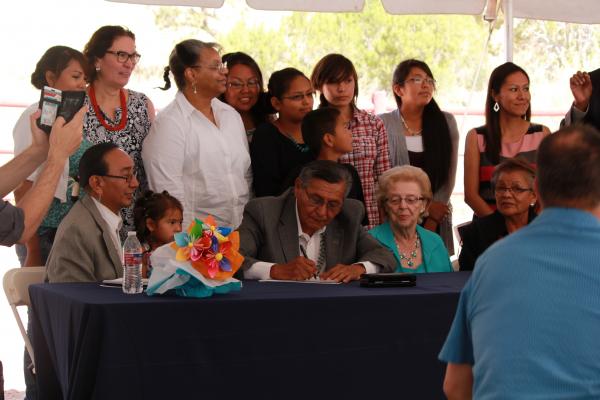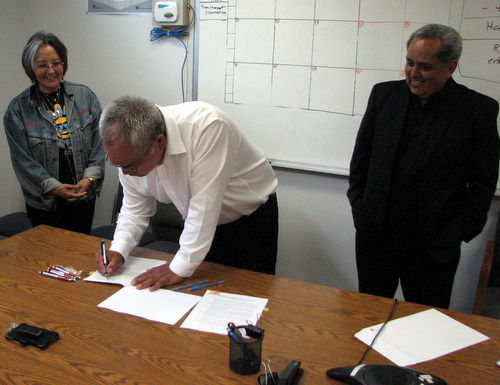Window Rock, Arizona—On Friday, June 27, the Navajo Nation made an historic pact with the U.S. Department of of Health and Human Services to execute a direct funding agreement through the Title IV-E program under the Social Security Act that will reimburse the tribe and its child welfare agencies for federally eligible foster care, adoptions and guardianships.
The reimbursements cover maintenance, including room and board; administration, including determination of Title IV-E eligibility, placement of the child, development of a case plan, and other administrative duties under the act; and short- and long-term training for the tribe, including child welfare agencies and court personnel. Title IV-E reimbursements are open-ended and are not a grant, according to the DHHS.
The Navajo Nation tribal jurisdiction covers three states: New Mexico, Arizona and Utah, but if a child was placed into state care, each of those states made the eligibility determination and placed the child. Meanwhile, the tribe’s social workers had to plead with each of the three states to return the child to the Navajo jurisdiction to be placed with one of its licensed foster homes. Additionally, the tribe only received funding from the state of New Mexico. Arizona and Utah did not provide Title IV-E reimbursements to the tribe.
Through this agreement with the U.S. Administration for Children and Families, however, the Navajo Nation will now make its own eligibility determinations and home placements within its jurisdictional borders in all three states and receive federal funding to assist the foster families to help in taking care of its own children. In qualifying for this direct funding agreement, the Navajo Nation is setting a national precedent for other tribes to follow.
RELATED: 5 Sioux Tribes Applied to Fund Their Own Foster Care Programs
“The Title IV-E is a model program for other Indian tribes throughout the United States,” said Sharon Begay-McCabe, director of the Navajo Nation Division of Social Services. “Because tribes have an input on how their program will be administered and [how to] incorporate their tribal culture into the plan. Native Americans, including Navajo, believe that children should be raised within their immediate family or within their Indian tribe. The family bond Navajo is their matrilineal clan system and families can exercise these traditional customs by keeping the children in kinship and permanent placement. Our children are the future leaders of our tribes and we must continue to hold them sacredly and keep them safe.”
Begay-McCabe, said that the tribe had been working since 2011 to qualify for the federal funding with a $300,000 planning grant. According to tribal officials, Title IV-E is an annual appropriation with specific eligibility requirements and fixed allowable costs for uses of funds. In fiscal year 2010, the direct funding provision was made available to Indian nations, tribal organizations and tribal consortia with approved plans to operate the program. The Navajo Nation is the first tribe to qualify for the funding.
“The Navajo Division of Social Services requested a one year extension and used its own resources to complete the Title IV-E plan, including the assistance from the Casey Family Foundation,” said Begay-McCabe. “Once the Title IV-E plan was submitted for approval, it took additional time to finally obtain the approval from DHS.”
In addition to the Casey Family Foundation, the tribe also partnered with the Navajo Nation Judicial Branch, Division of Public Safety, Office of the Chief Prosecutor, Office of the Chief Public Defender, Department of Dine’ Education, Division of Health and the Office of the President and Vice President in getting the direct funding agreement approval.
“The Navajo Division of Social Services is the first tribal program in the country to administer the Title IV-E program,” said Navajo Nation President Ben Shelly. “I commend Sharon McCabe and her staff for making this possible. Our kids are important and we must do everything we can to protect them.”
Tribal officials said the program is set to go into effect on October 1, 2014. Until that time, the tribe’s Department of Family Services will begin trainings, which will include the Navajo Nation Courts and other tribal programs that will cover eligibility requirements for the children and families receiving Title IV-E and the requirements of language in the courts’ rulings.
Currently, the tribe only receives funding for six children, but the new program could impact up to 200 Navajo children currently in foster care, said Begay-McCabe.
“Title IV-E enhances tribal sovereignty, [because] the Navajo Nation will receive direct funding from the federal government,” said Begay-McCabe “Before, the Division had to work with the three states – Arizona, New Mexico and Utah – individually to receive Title IV-E. The Division had to follow the process of eligibility, which differs in each state and was not culturally sensitive. Now, the Division will administer the whole Title IV-E program for the tribe, [which] will keep our children safe, provide permanency, and incorporates Navajo culture that will enhance our tribal sovereignty.”
Read more at http://indiancountrytodaymedianetwork.com/2014/06/30/navajo-nation-makes-historic-agreement-dhhs-handle-its-tribal-foster-care-155568







